【English】Causes and Symptoms of Syndromic Craniosynostosis such as Crouzon Syndrome and Apert Syndrome
Causes and Symptoms of Syndromic Craniosynostosis such as Crouzon Syndrome and Apert Syndrome
The multiple joints of the bones that constitute the skull are called suture lines. If the suture lines fuse during the fetal period or during the early postnatal period due to gene abnormalities, the bones in the head and face may not grow, which can result in various symptoms arising from increased pressure on the brain, such as protrusion of the eyeballs, headaches and nausea. The major result of such genetic disorders, syndromic craniosynostosis, has been designated as an intractable disease in the field of malformation syndrome, and a research team of the Ministry of Health, Labour and Welfare is working to elucidate its pathological conditions and therapeutic developments.
What is Syndromic Craniosynostosis as Typified by Crouzon Syndrome?
In this disorder, lesions occur not only in the head, but also in facial regions. Craniosynostosis is divided basically into nonsyndromic and syndromic craniosynostosis. In nonsyndromic cases, lesions are localized in the head, whereas in syndromic cases, lesions occur not only in the head but also in the face. For example, in the latter case symptoms may develop in the upper jaw or trachea. In this article, I will discuss the following four common types of syndromic craniosynostosis:- Crouzon syndrome
- Apert syndrome
- Pfeiffer syndrome
- Antley-Bixler syndrome
What are the suture lines essential for normal skull growth?
Understanding Craniosynostosis
In order to understand syndromic craniosynostosis, it is important to know how the bones in the head grow. The human skull is composed of multiple bones, and their joints are called suture lines. There are two main mechanisms by which the skull grows and is enlarged. One is the so-called remodeling mechanism, in which the bone tissues are resorbed on the inner side and added on the surface. The other is suture lines.
The skull grows and enlarges as the number of cells in the suture lines increase. Thus, if the suture lines are fused and closed during the fetal period or shortly after birth, the skull does not enlarge and pressure on the brain increases. The suture lines, which are essential for the growth of the skull, will be congenitally fused earlier than those in a healthy person. For this reason, it is called "craniosynostosis."
Craniosynostosis is a congenital disorder, but the rate of progression varies, and symptoms often develop as the person grows. In addition, the earlier the suture lines fused, the more severe the symptoms tend to be.
Syndromic craniosynostosis is a disorder that only affects the bones, when seen only in the craniomaxillofacial area. Except for the bones, the eyes and muscles are almost normal.
Earlier, I mentioned that syndromic craniosynostosis also causes lesions on the face. It is important, however, to understand that this disorder is essentially a disease that affects only the bones. For example, the soft tissues, muscles, and eyes in the facial regions grow almost normally (with some exceptions). So it does not mean that the eyeballs of a patient with syndromic craniosynostosis are large, but that the eyes look relatively "larger" because the bones around the eyes do not grow.
Craniosynostosis and Mental Retardation
Mental retardation is a symptom that can occur in some patients with normal brain development being impaired because the suture lines fused prematurely and the skull, the container of the brain, does not grow. However, mental retardation may not occur in all disorders.
Frequency of Mental Retardation due to Four Typical Disorders
Crouzon syndrome is infrequently accompanied by mental retardation, and Apert syndrome is known to be more frequently associated with mental retardation than Crouzon syndrome. In Pfeiffer syndrome, the severity and symptoms of the syndrome vary according to the type of disease, and so it is not possible to give a general description of the frequency of mental retardation. Antley-Bixler syndrome may also be accompanied by mental retardation.
Hereditary Forms of Craniosynostosis
All the syndromes, except for Antley-Bixler syndrome, are inherited as an autosomal dominant trait. Crouzon, Apert and Pfeiffer syndromes are autosomal dominant hereditary disorders. However, if either of the parents has causative gene mutations, there is a 50% chance of the child developing the disease. Of the four diseases, only Antley-Bixler syndrome has an autosomal recessive pattern of inheritance.
Causes of Crouzon Syndrome and Number of Patients
The causative genes have been elucidated. Crouzon syndrome is caused by abnormalities in the gene called the FGFR2 gene. It may be caused, in some cases, by abnormalities in the FGFR3 gene. However, the mechanism by which the suture lines become fused early is unclear. We estimate, according to our experience that the annual incidence of Crouzon syndrome in Japan is 20-30.
What are the Symptoms of Crouzon Syndrome?
The symptoms arise from increased intracranial pressure, such as headaches, vomiting, and nausea
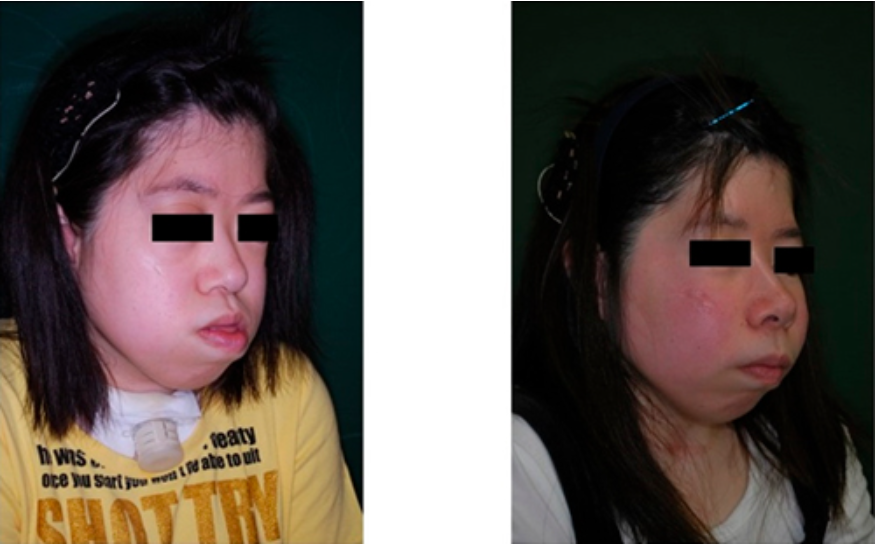
Symptomatic Crouzon Syndrome
The image on the right was taken after treatment
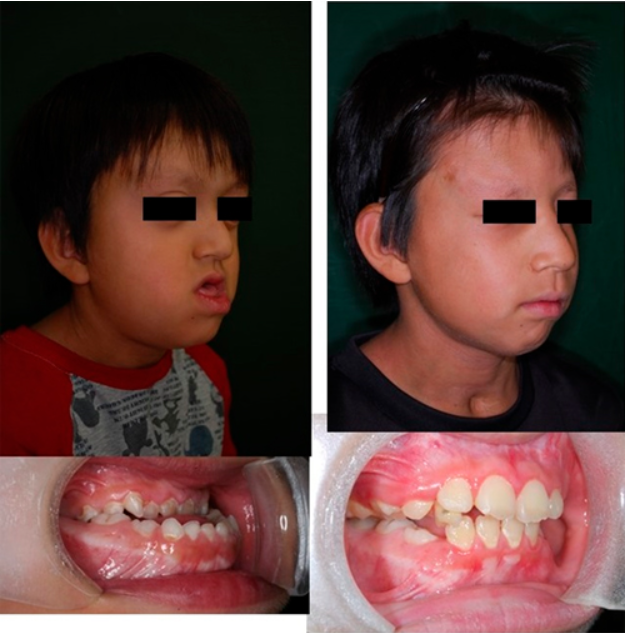
Symptoms of Crouzon Syndrome 2
The image on the right was taken after treatment
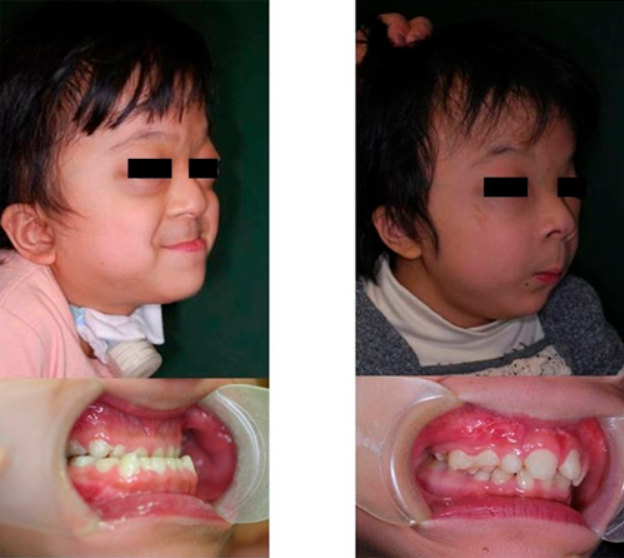
Symptoms of Crouzon Syndrome 3
The image on the right was taken after treatment
Due to the small size of the skull, pressure on the brain increases, causing headaches, vomiting, and nausea. These symptoms of increased intracranial pressure are not common soon after birth, and most develop with growth and are diagnosed. Hydrocephalus may also result from a narrow outlet for the cerebrospinal fluid produced.
These symptoms can be alleviated by repeating surgeries to enlarge the skull several times during the person's lifetime. For details of the surgical procedures, please refer to "Minimally Invasive Procedures for Syndromic Craniosynostosis — Bone Lengthening Method with Two Types of Fixation Devices"
Causes and Symptoms of Apert Syndrome
Symptoms manifest themselves in the head and facial regions, syndactyly, and the inability to bend the elbows are also caused by abnormalities in the FGFR2 gene. The main symptoms are protruding eyeballs due to impaired brain development, as well as breathing difficulties. In addition, a characteristic symptom of fused fingers and toes and an inability to bend the elbows may occur.
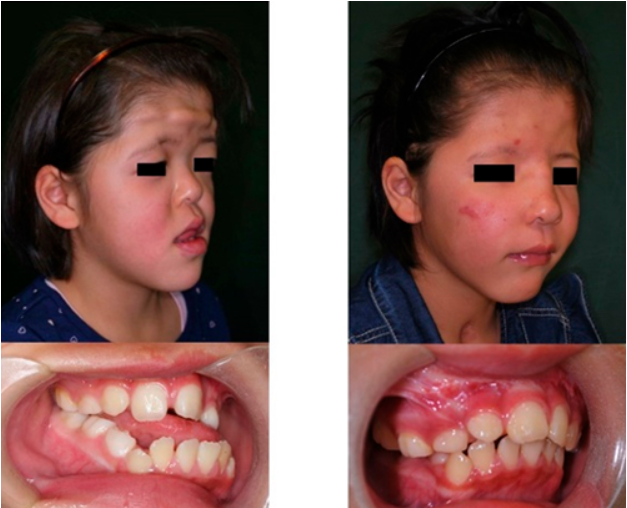
Symptom of Apert Syndrome
The image on the right was taken after treatment
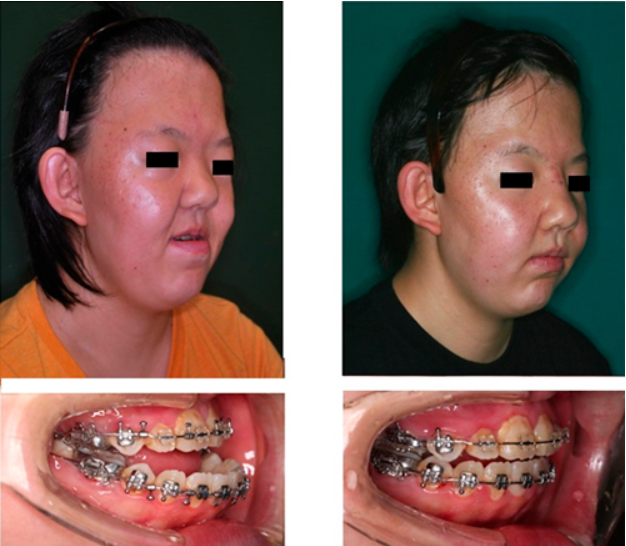
Symptom of Apert Syndrome 2
The image on the right was taken after treatment
In the case of Apert syndrome—unlike mild Crouzon syndrome—symptoms often appear soon after birth, and so most are diagnosed during the neonatal period.
Number of Patients with Apert Syndrome
Kanagawa Prefecture conducted an unprecedented large-scale monitoring survey that showed the incidence of Apert syndrome is about 1 in 150,000. As a result, the annual incidence in Japan is estimated to be around 8.
Causes and Symptoms of Pfeiffer Syndrome
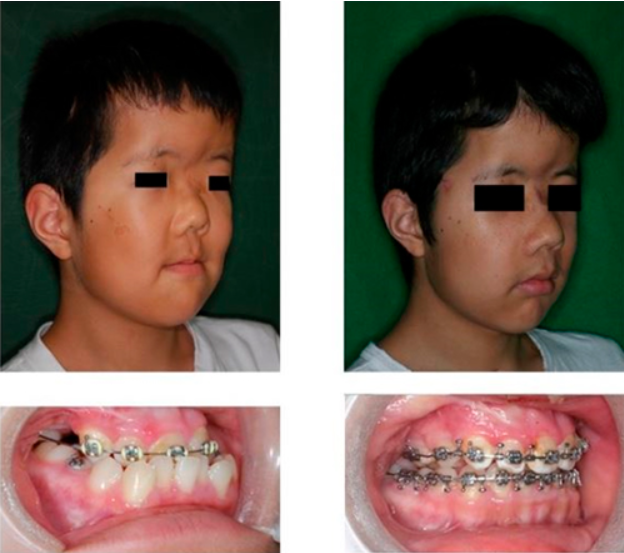
Symptoms of Pfeiffer Syndrome
The image on the right was taken after treatment
Pfeiffer syndrome is caused by abnormalities in the FGFR2 gene. Mild cases may result from abnormalities in the FGFR1 gene. The main symptoms are protruding eyeballs, impaired breathing, and fused fingers and toes, and the severity of these symptoms depends on the type of the disorder.
Number of Patients with Pfeiffer Syndrome
Compared with Crouzon syndrome, Pfeiffer syndrome is a rare disease. We estimate, based on our experience, that the annual incidence of Pfeiffer syndrome is around 6 in Japan.
Causes of Antley-Bixler Syndrome and Number of Patients
The following are three causes of Antley-Bixler syndrome:
- Abnormalities in the gene called the POR gene
- Abnormalities in the gene called the FGFR2 gene
- Overdose of fluconazole (antifungal drug)
Antley-Bixler syndrome is a rare disease with the number of patients and annual incidence unknown.
What Are the Symptoms of Antley-Bixler Syndrome?
The symptoms are associated with a deficiency of steroid hormones. Symptoms of Antley-Bixler syndrome are characterized by symptoms arising from premature fusion of the skull and by the symptoms of lengthened fingers and inability to bend the elbow due to fusion. In addition, unlike the three diseases described above, Antley-Bixler syndrome is accompanied by a deficiency in steroid hormones.
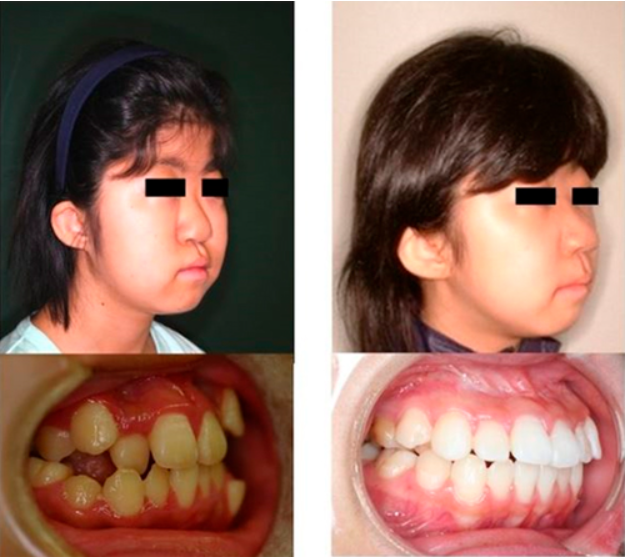
Symptom of Antley-Bixler Syndrome
The image on the right was taken after treatment
In the surgeries for the four diseases described above, a method called "Bone Lengthening" was used to pull out the facial bones to their normal positions.
"Minimally Invasive Procedures for Syndromic Craniosynostosis—Bone Lengthening with Two Types of Fixation Devices," I will explain the specific methods of bone lengthening.












